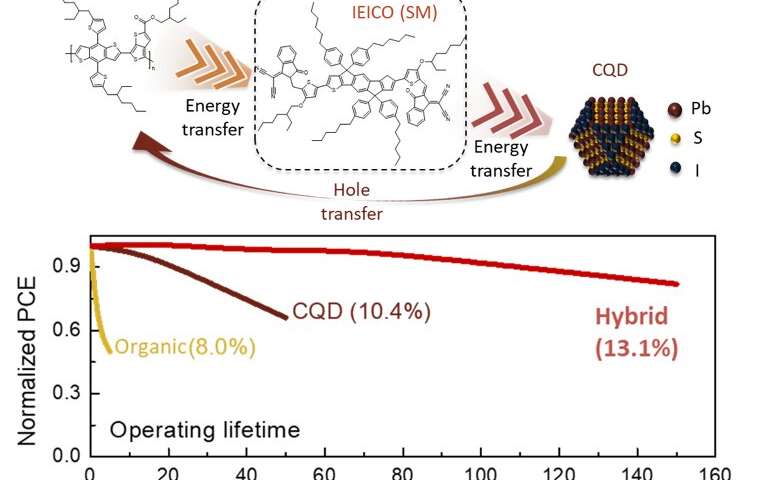
Recently, some studies have highlighted the advantages of fabricating semiconductors by combining colloidal quantum dots (CQDs), nanoparticles that can harvest infrared photons, and organic chromophores, parts of a molecule that absorb visible light photons and give color to the molecule. Nonetheless, so far, hybrid photovoltaic based on CQDs and chromophores have only achieved power conversion efficiencies (PCEs) below 10 percent due to a chemical mismatch between different components and challenges in enabling charge collection.
Researchers at the University of Toronto and KAIST in South Korea have recently developed a hybrid architecture that overcomes these limitations by introducing small molecules into a CQD/organic stacked structure. The hybrid solar cells they created, presented in a paper published in Nature Energy, achieved remarkable PCEs that are retained even after long periods of continuous operation.
"The first challenge of this study was to combine the advantages of the broad photo-absorbing band of CQDs and the strong (but narrower) absorption coefficient of organic molecules to create a higher performance photovoltaic platform," Se-Woong Baek, one of the researchers who carried out the study, told TechXplore.
The researchers drew inspiration from a study carried out by a research team at Berkeley National Laboratory almost two decades ago, which demonstrated the potential of using semiconductor nanorods and polymers to fabricate hybrid solar cells. While the team at Berkeley Lab and several others tried to combine organic molecules with CQDs, Baek and his colleagues felt that this was difficult to achieve, as device performances achieved by their hybrid architectures were lower than typical organic or CQD-only semiconductors. Thus, they set out to investigate the potential of CQD/organic semiconductors further, trying to overcome the limitations of previously developed architectures.
For solar cells to perform well, they should be able to maximize light absorption and efficiently convert it into electrical current. The hybrid solar cells developed by Baek and his colleagues have a small molecule bridge that complements CQD absorption, which in turn creates an excitor cascade with the host polymer. This results in a more efficient energy transfer than that observed in other hybrid architectures.
"The structure we developed can achieve high light harvesting efficiency via an additional organic layer, which has a strong absorption coefficient at its backside and a primary broadband absorption by CQD near its front side," Baek explained. "The strongest advantage of the resulting solar cells is that they allow us to program the photo-response of CQD by resizing and combining it with suitable organic molecules."
The unique structure of the solar cells developed by Baek and his colleagues allows for greater degrees of freedom in programming their functions compared to other types of hybrid solar cells. In addition, it allows the solar cells to maintain good efficiency over longer periods of continuous operation.
"Many previous studies have reported broad and high absorbance through a combination of CQD and polymers, but their performance was less efficient due to the low charge extraction efficiency," Baek said. "By introducing the third component, a small molecule bridge, into CQD/polymer hybrid heterostructure, we revealed an underlying mechanism that facilitates charge extraction as well as absorption, thereby improving PCEs."
In the future, these solar cells could be used to fabricate photovoltaic panels that use both quantum dots and chromophores, but that achieve higher efficiencies than those observed in previously developed hybrid architectures. So far, the CQD-organic structure they proposed has an absorption band up to 1100 nanometers. In their next studies, they would thus like to adapt the structure or develop alternative hybrid architectures to achieve broader absorption bands.
"Eventually, this structure could be combined with actually high band-gap perovskite solar cells, for example, by designing a rear-cell platform as a tandem structure that can reinforce the absorption of the near-infrared band, where perovskite does not absorb," Baek said. "Theoretically, an efficiency of 15 percent can be added to the perovskite solar cell when we combine our hybrid structure as a rear-cell of tandem structure."







